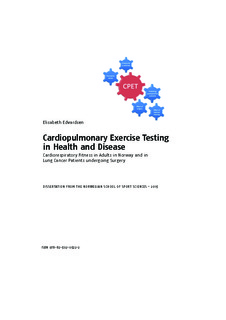| dc.contributor.author | Edvardsen, Elisabeth | |
| dc.date.accessioned | 2016-04-21T10:43:53Z | |
| dc.date.available | 2016-04-21T10:43:53Z | |
| dc.date.issued | 2015 | |
| dc.identifier.isbn | 978-82-502-0522-2 | |
| dc.identifier.uri | http://hdl.handle.net/11250/2386730 | |
| dc.description.abstract | Maximal oxygen uptake (VO2max) is used to quantify an individual’s exercise capacity and is recognized as the main variable for measurement during cardiopulmonary exercise testing (CPET). There are limited reference values for VO2max and other cardiorespiratory fitness variables measured during CPET. There are also few typical criteria for ascertaining that the subject has achieved the maximum effort needed to ensure a valid measurement, especially among women and elderly people. In patients with Non-Small-Cell lung cancer (NSCLC), VO2max is a cornerstone in the preoperative evaluation. Many patients have poor physical fitness, which may decline further after surgery. The accuracy of the predicted postoperative functional outcome (pulmonary function and VO2max) recommended in the European risk assessment guidelines has not been investigated thoroughly. After lung surgery, there is little that can be done to improve lung function and the area for gas exchange, and exercise training may be the single most important aspect of adjuvant treatment to increase daily function and quality of life. However, knowledge about the feasibility and effects of training after lung resection is limited. The overall objectives of this thesis were to: 1. Determine the cardiorespiratory response during maximal treadmill exercise in a well-described representative sample of 20-to 85-year-old men and women in Norway. 2. Identify the end criteria for determining that a subject has reached VO2max. 3. Evaluate the effect of lung cancer surgery on cardiorespiratory fitness measured on a treadmill, and to assess the agreement between the predicted postoperative peak oxygen uptake (VO2peak) and actually measured postoperative VO2peak. 4. Study the effect of high-intensity endurance and strength training on VO2peak, pulmonary function, muscular strength, functional fitness, body composition, and quality of life in a randomised controlled trial of newly resected NSCLC patients. | nb_NO |
| dc.description.abstract | Paper I: Edvardsen E, Hansen BH, Holme IM, Dyrstad SM, Anderssen SA. Reference Values for Cardiorespiratory Response and Fitness on the Treadmill in a 20-85-year-old Population. Chest; 2013, 144 (1), 241-248 | |
| dc.description.abstract | Paper II: Edvardsen E, Hem E, Anderssen SA. End Criteria for reaching Maximal Oxygen Uptake must be Strict and Adjusted to Sex and Age. Plos One; 2014, 9 (1), e85276 | |
| dc.description.abstract | Paper III: Edvardsen E, Anderssen SA, Borchsenius F, Skjønsberg OH. Reduction in Cardiorespiratory Fitness after Lung Cancer Surgery is not related to Amount of Lung Tissue Removed. In manuscript. | |
| dc.description.abstract | Paper IV: Tatt ut av filen i Brage p.g.a. copyright-restriksjoner. / Not in the file in Brage because of copyright issues. | |
| dc.language.iso | eng | nb_NO |
| dc.subject | maksimalt oksygenopptak | nb_NO |
| dc.subject | aerob kapasitet | nb_NO |
| dc.subject | utholdenhetstrening | nb_NO |
| dc.subject | lungesykdommer | nb_NO |
| dc.subject | kreft | nb_NO |
| dc.title | Cardiopulmonary exercise testing in health and disease: cardiorespiratory fitness in adults in Norway and in lung cancer patients undergoing surgery | nb_NO |
| dc.type | Doctoral thesis | nb_NO |
| dc.subject.nsi | VDP::Medical disciplines: 700 | nb_NO |
| dc.subject.nsi | VDP::Mathematics and natural science: 400::Basic biosciences: 470 | nb_NO |
| dc.subject.nsi | VDP::Agriculture and fishery disciplines: 900::Agriculture disciplines: 910 | nb_NO |
| dc.description.localcode | Seksjon for idrettsmedisinske fag / Department of Sports Medicine | nb_NO |
